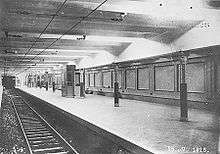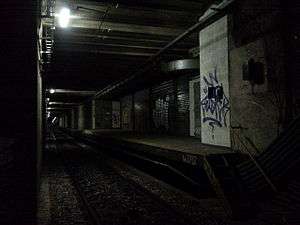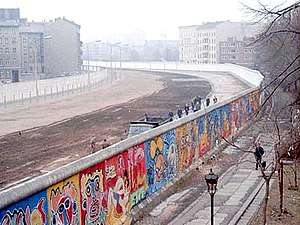Ghost station
A ghost station is a disused railway station through which revenue-service passenger trains (especially rapid transit trains) pass but at which they do not stop. The term is also sometimes used for any unused underground station or any unused station at all, whether or not revenue-service trains pass by them at all.
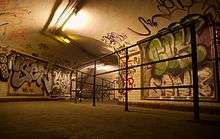
Etymology
The term "ghost station" is a calque of the German word Geisterbahnhof (plural Geisterbahnhöfe). The German term was coined to describe certain stations on Berlin's U-Bahn and S-Bahn metro networks that were closed during the period of Berlin's division during the Cold War because they were an integral part of a transit line mostly located on the other side of the Berlin Wall.
Ghost stations in Berlin
Background
_en.svg.png)
In August 1961 the East German government built the Berlin Wall, ending freedom of movement between East and West Berlin. As a result, the Berlin public transit network, which had formerly spanned both halves of the city, was also divided into two. Some U- and S-Bahn lines fell entirely into one half of the city or the other; other lines were divided between the two jurisdictions, with trains running only to the border and then turning back. However, there were three lines—the U-Bahn lines now designated U6 and U8, and the Nord–Süd Tunnel on the S-Bahn—that ran for the most part through West Berlin but passed for a short distance through the borough of Mitte (the historic city centre), which was East Berlin territory. These lines continued to be open to West Berliners; however, trains did not stop at most of the stations located within East Berlin, though for technical reasons they did have to slow down significantly while passing through.[1] (Trains did stop at Friedrichstraße, on which more below.) The name Geisterbahnhof was soon aptly applied to these dimly lit, heavily guarded stations by travellers from West Berlin, who watched them pass by through the carriage windows. However, the term was never official; West Berlin U-Bahn maps of the period simply labelled these stations "Bahnhöfe, auf denen die Züge nicht halten" ("stations at which the trains do not stop"). East Berlin maps neither depicted the West Berlin lines nor the ghost stations. U-Bahn maps in the Friedrichstraße transfer station were unique: They depicted all the Western lines, but not the Geisterbahnhöfe, and showed the city divided into "Berlin, Hauptstadt der DDR" ("Berlin, capital of the German Democratic Republic") and "Westberlin", the official terminology used by East Germany.
The situation was obviously less than ideal. The lines were a vital part of the West Berlin transit network, but because part of the route of some of the lines lay in East Berlin territory, it was difficult for Western support staff to perform maintenance work on the tracks and tunnels. If a train on a West Berlin line broke down in East Berlin territory, then passengers had to wait for Eastern border police to appear and escort them out. The East German government occasionally hinted that it might someday block access to the tunnels at the border and run its own service on the East Berlin sections of these lines. However, this awkward status quo persisted for the entire 28-year period of the division of Berlin.
At the closed stations, barbed wire fences were installed to prevent any would-be escapees from East Berlin from accessing the track bed, and the electrically live third rail served as an additional and potentially lethal deterrent. An alarm was triggered if anyone breached one of the barriers. As for the entrances, the signage was removed, walkways were walled up and stairways were sealed with concrete slabs. Police stations were built into the windowed platform service booths, from which the whole platform area could be monitored.
A wide white line on the wall marked the exact location of the border. Later, gates were installed at some stations that could be rolled into place at night while the guards were off-duty. Guard posts at other stations were staffed continuously, creating additional employment positions with the transport police. In the platform area, the guards always worked in pairs, and care was taken in their assignment to assure that there would be no personal ties between them. In addition, superior officers could conduct surprise inspections at any time, thus, maintaining maximum security. Other stations were secured by the East German border guards.
Particular stations
Friedrichstraße station, though served by Western lines and located in East Berlin territory, was not a Geisterbahnhof. Instead, it served as a transfer point between U6 and several S-Bahn lines. Western passengers could walk from one platform to another without ever leaving the station or having to show papers, much like air travellers changing planes at an international airport. Westerners with appropriate visas could also enter East Berlin there.
The Bornholmer Straße S-Bahn station was the only ghost station not located in a tunnel. It was situated close to the wall near the Bornholmer Straße border crossing. West Berlin trains passed through it without stopping. East Berlin S-Bahn trains passed the same station but on different tracks. The tracks used by Western and Eastern trains were sealed off from each other by a tall fence.
Another oddity was Wollankstraße station. Like Bornholmer Straße, it was an S-Bahn stop served by West Berlin trains, but located on East Berlin territory just behind the border. However, Wollankstraße was in use and accessible for West Berliners, as one of its exits opened on a West Berlin street. This exit was exactly on the border line, a warning sign next to it informing passengers about the situation. Its other exits to East Berlin streets were blocked.
Reopening
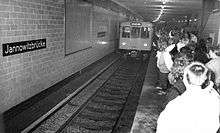
The first people to enter the ghost stations after the fall of the Berlin Wall in November 1989 found that they lived up to their informal name, with ads and signage on the walls unchanged since 1961. None of them have been preserved.
The first ghost station to reopen to passenger traffic was Jannowitzbrücke (U8) on 11 November 1989, two days after the fall of the Wall. It was equipped with a checkpoint within the station akin to Friedrichstraße, where East German customs and border control were provisionally installed to facilitate passengers heading to or coming from East Berlin. Hand-drawn destination signs were hung up covering the old ones from pre-1961; these signs were both crumbling from age and obviously missing the termini of post-1961 line extensions. On 22 December 1989, Rosenthaler Platz (U8) was reopened with a similar provisional checkpoint.
On 12 April 1990, the third station to reopen was Bernauer Straße (U8). As its northern exit was directly on the border, it could be opened with direct access to West Berlin without the need of a checkpoint. Its southern exit towards East Berlin was not reopened until 1 July 1990.
Discussions about reopening all the U6 and U8 stations including the S-Bahn station Oranienburger Straße, Unter den Linden and Nordbahnhof had begun on 13 April 1990 without border controls. These took two months to clean up, removing all the dirt and refurbishing the interiors; all stations had been reopened on 1 July 1990 at 11 a.m., as East Berlin and East Germany had adopted the West German currency (DM), leaving the border checkpoints abandoned.
On 2 July 1990, Oranienburger Straße was the first ghost station on the Nord-Süd-S-Bahn to reopen. On 1 September 1990, Unter den Linden and Nordbahnhof were opened following reconstruction works. On 12 December 1990, Bornholmer Straße was reopened for West Berlin trains; a second platform for East Berlin trains allowing interchange followed on 5 August 1991. The very last ghost station to reopen was Potsdamer Platz, which opened on 3 March 1992, following an extensive restoration of the entire North–South tunnel.
In the following years, the city and German government put a great deal of effort into restoring and reunifying the S-Bahn and U-Bahn networks in Berlin. The U-Bahn system reached its pre-war status in 1995 with the reopening of Warschauer Straße on U1. The S-Bahn system reached a preliminary completion in 2002 (with the reopening of the ring), even though there are still disused sections of lines closed in the aftermath of the wall. Decisions on reopening of some of these sections are still to be made.
List of all Berlin ghost stations
This list only includes those stations in East Berlin territory that western trains passed through without stopping. There were other stations on both sides of the wall that were closed during the division because those sections of track were not in use.
Temporary checkpoints were set up for stations with access to East Berlin that were reopened before 1 July 1990. Checkpoints were no longer necessary for those reopened after that date when border checks were eliminated with the currency union between East and West Germany.
| List of Berlin's ghost stations as a result of the Cold War | ||||
|---|---|---|---|---|
| Nord–Süd S-Bahn (S1, S2 and S25) | ||||
| No. | Station | Date reopened | Remarks | Order of reopening |
| 1 | Bornholmer Straße | 12 December 1990 | 7 | |
| 2 | Nordbahnhof | 1 September 1990 | 6 | |
| 3 | Oranienburger Straße | 2 July 1990 | First S-Bahn ghost station to reopen | 5 |
| 4 | Unter den Linden | 1 September 1990 | Renamed Brandenburger Tor station | 6 |
| 5 | Potsdamer Platz | 3 March 1992 | 8 | |
| U 6 | ||||
| 1 | Schwartzkopffstraße | 1 July 1990 | From approximately 1951 to 1971, the Schwartzkopffstraße station bore the name Walter-Ulbricht-Stadion after a nearby stadium named in honour of Walter Ulbricht, then the First Secretary of the Socialist Unity Party (SED) and de facto leader of East Germany. In 1971, when Ulbricht was deposed and replaced by Erich Honecker, the stadium and station were renamed Stadion der Weltjugend (Stadium of World Youth) although the only trains that passed through the station were from West Berlin and did not stop there. The original name was restored in 1991. | 4 |
| 2 | Nordbahnhof | 1 July 1990 | Renamed Zinnowitzer Straße (1991–2009), then Naturkundemuseum (from 2009) | 4 |
| 3 | Oranienburger Tor | 1 July 1990 | 4 | |
| 4 | Französische Straße | 1 July 1990 | 4 | |
| 5 | Stadtmitte | 1 July 1990 | Only the U6 station was closed. East Berlin Underground line A (part of today's U2) trains continued to stop here. | 4 |
| U 8 | ||||
| 1 | Bernauer Straße | 12 April 1990 | Only direct access to West Berlin was opened on this date (without the need for a checkpoint). The southern exit to East Berlin was not reopened until 1 July 1990. | 3 |
| 2 | Rosenthaler Platz | 22 December 1989 | Temporary checkpoint set up for border crossing into East Berlin. | 2 |
| 3 | Weinmeisterstraße | 1 July 1990 | 4 | |
| 4 | Alexanderplatz | 1 July 1990 | Only the U8 station was closed. East Berlin Underground line A (part of today's U2), and line E (today numbered U5), as well as S-Bahn trains continued to stop here. | 4 |
| 5 | Jannowitzbrücke | 11 November 1989 | Only the U8 station was closed. East Berlin S-Bahn trains continued to stop here. After reopening, checkpoints were set up for border crossing into East Berlin. | 1 |
| 6 | Heinrich-Heine-Straße | 1 July 1990 | 4 | |
New ghost stations after reunification
In contrast with the above-listed stations, multiple stations in the Berlin area that were of high importance during the Cold War rapidly lost importance and passengers after reunification, some to the point of becoming ghost stations. The most notable examples are:
- Genshagener Heide (in German): station on the Berlin Outer Ring located due south of Berlin, quite far from any populated place, lost its importance with the resumption of direct routes from the Potsdam area to East Berlin and due to the reduction of the workforce in the Industriewerke Ludwigsfelde factory located nearby. Trains running between Potsdam and the Berlin Schönefeld Flughafen station stopped at the station until December 2012. Since then all passenger trains pass through without stopping and it was officially reclassified to a Betriebsbahnhof (service station). A train stop named Ludwigsfelde-Struveshof was built 2 km to the west (closer to populated areas) and brought into service with the closure of the Genshagener Heide station.
- Potsdam Pirschheide: an interchange station also located on the Berlin Outer Ring on the outskirts of Potsdam, named Potsdam Hauptbahnhof (Potsdam Main station) between 1961 and 1993, was the most important station of Potsdam when the traffic flow to West Berlin (Berlin–Magdeburg railway) was severely restricted. After resumption of service between Potsdam and Berlin-Wansee station, the Pirschheide station lost its importance, became unstaffed in 1994. Tracks on the upper deck were demolished in 1999 (leaving only a pair of through tracks not adjacent to any platform), and on the lower deck only a single platform was left in service for use by the local trains from Potsdam to Michendorf. Although its present-day importance is negligible and its decaying appearance is not unlike "real" ghost stations from the Cold War era, it still has regular passenger trains stopping at it.
Ghost stations elsewhere
Argentina
The Buenos Aires Underground has four ghost stations. The two stations on Line A were originally two single-platform stations closed in 1953 since their close proximity meant trains had to stop in quick succession and frequencies were reduced. Their opposing platforms, located just metres away from each of the ghost stations, still remain open as Pasco and Alberti stations. The stations are preserved to maintain their original appearance and can still be seen when travelling on the line, even being used as a display for a time.[2]
On Line E, the two stations were closed in 1966 when the line was re-routed closer to the centre of Buenos Aires in order to improve passenger numbers. They have both been used as maintenance areas for Line E and Line C, while one of the stations served as a set for the 1996 Argentine film Moebius. The stations were under consideration to be re-purposed as part of the new Line F, however it was later decided to build new tunnels instead.[3]
There are also two stations (Apeadero Boedo and Apeadero Carranza) on Line E and Line D which were designed to be used as temporary stations while their respective lines were being extended. Though the platforms remain, they cannot be considered true ghost stations since they were never intended to be a permanent part of the network and designed to be re-purposed as electrical substations once the permanent stations were built.
Australia
- General Motors on the Melbourne train network. (Not an underground station, nor part of an underground network).
- Nyanda railway station (between Rocklea and Salisbury) on the Gold Coast railway line, Brisbane. (Not an underground station, nor part of an underground network).
- Woollahra on the Eastern Suburbs Line. (Not an underground station, partially constructed but never opened).
Austria
- Vienna Underground Railway (U-Bahn): Station Lerchenfelder Straße of line U2 closed in 2013 and the old Westbahnhof station.
- Vienna Rapid Transit (S-Bahn): several stations have been closed: Radetzkyplatz, Brigittenau Vorortebahnhof, Baumgarten in 1939, the old Praterstern station, Strandbäder in 2000, Kahlenbergerdorf in 2004, Breitenleer Straße in 2010
Brazil
- Paraíso (São Paulo Metro), platforms of the Moema branch, never opened
- Pedro II (São Paulo Metro), underground docks that would serve the Southeast-Southwest line, but which would not have been put into service
- Pirelli Station (CPTM São Paulo) in Santo André
- Paranapiacaba Station (CPTM São Paulo) in Paranapiacaba in Santo André
- Diretor Pestana station, in Porto Alegre. An old station formerly used in a passenger train line from Porto Alegre to Santa Maria, and currently only cargo trains pass through it in service, while metropolitan trains operated by the Trensurb line only pass there while maneuvering. Aeroporto station of the Trensurb, serving Porto Alegre airport, was built right beside the Diretor Pestana station.
Bulgaria
- St. Naum Station (Станция Свети Наум) and NDK Station (Станция НДК) of the Sofia Metro. Both stations were built in the 1980s, together with the National Palace of Culture and the redevelopment of the surrounding area. Currently these stations are fully completed and had become operational on 31 August 2012. St. Naum Station is operating under the name of European Union Metro Station.
- Moderno Predgradie Station (Станция Модерно предградие).
Canada
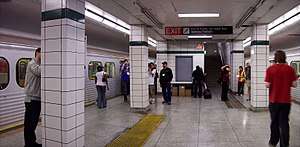
- Lower Bay in Toronto. Below the main platform for Bay station is an abandoned level which was used for only six months in 1966 when the Toronto Transit Commission (TTC) experimentally interlined portions of both the Yonge–University and Bloor–Danforth lines. This abandoned platform is sometimes referred to as "Lower Bay" by the general public or "Bay Lower" by the TTC.[4]
- Municipal Building in Calgary. A downtown subway was originally planned under 8th Avenue for the Calgary C-Train. In preparation, a short section of tunnel and underground LRT station were built under the Calgary Municipal Building when it was constructed in 1985. Subway plans were halted because the initial surface line on 7th Avenue turned out to have much more passenger capacity than expected. The underground station and downtown subway may be completed in the foreseeable future as future C-Train lines which are under construction and proposed will exceed the capacity of the 7th Avenue surface line.[5]
Chile
Libertad station, located in between Cumming and Quinta Normal in Line 5 of the Santiago Metro, is a ghost station that was closed because there wasn't enough passenger demand for the station due to the low density of people traveling around and through it. Echeverría is a ghost station located in Line 4A, also closed because of the low density of people traveling around and through it. The original project of the line 3 side of Puente Cal y Canto metro station is also a ghost station. The entire line 3 was canceled because of the 1985 Algarrobo earthquake.
Czech Republic
- Hloubětín and Kolbenova stations on Line B of Prague Metro were ghost stations from 1998 to 1999 (2001 for Kolbenova). The stations were in a state of suspended construction as the heavy industry factories they should have served were closed after the Velvet Revolution. Trains slowed down when passing through these dimly lit stations. As the whole industrial area was slowly revitalized the stations were finally completed.
- Národní třída station was closed from July 2012 to June 2014 due to construction of a new shopping and business centre. Trains passed through the station without stopping.[6]
China
- Fushouling in Beijing
Hong Kong
- Rumsey Station in the MTR. This platform was originally reserved for the East Kowloon Line proposal in the 1970s, in order to minimise the effects on the Island Line. However, these platforms are now abandoned and brick walls have been placed at the two ends of the 60 m (200 ft) long platforms to block them off. The station is now called Sheung Wan and formerly served as the terminus of the Island Line before the opening of West Island Line. Since the platforms were built as the upper platforms, passengers going to and from exit E must pass through the abandoned platforms. In preparation for the opening of the West Island Line extension the station was renovated, and the track area along the platforms was walled off.
Denmark
- Ellebjerg station is a former surface station on Køgebugtbanen (line A), which is a part of the S-train network in Copenhagen. The station was closed in 2007 when the Ny Ellebjerg station ("New Ellebjerg station") was built when Ringbanen (line F) was extended, with connections between these two lines.
Finland
The Kamppi metro station has an unused north–south station, below and at right angles to the east–west one currently in use. Excavated at the same time as the east–west station, it was never outfitted, because the corresponding north–south metro line was never built.[7] The Hakaniemi metro station has another similar ghost station, built for the U-line which was eventually not constructed, and its excavation remains incomplete. They don't have any trains and are not accessible. The University of Helsinki metro station is a former ghost station, since it was excavated in the late 1970s, but opened to the public in 1995.[8] Under Munkkivuori Shopping Centre in Helsinki is an unfinished space for Helsinki Metro station. Space was reserved during expansion work of shopping centre in early 60s but never used.
France
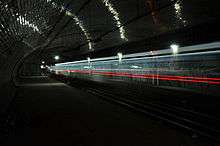
- Arsenal (Paris Métro)
- Champ de Mars (Paris Métro)
- Croix-Rouge (Paris Métro)
- Haxo (Paris Métro)
- Porte Molitor (Paris Métro)
- Saint-Martin (Paris Métro)
Germany
Apart from Berlin:
- Duisburg Light Railway (Stadtbahn): station Angerbogen, built, but never opened
- Düsseldorf Rapid Transit (S-Bahn): station Kalkum closed since 1990 and Station Abflug E at Düsseldorf Airport since 1998
- Hamburg Underground Railway (U-Bahn): station Beimoor, built, but never opened; station Hellkamp on line U2 and station Hauptbahnhof Nord
- Hanover Light Railway (Stadtbahn): part of station Hauptbahnhof, built, but never opened
- Cologne Light Railway (Stadtbahn): station Fixheider Weg closed in 2003, Deutz/Messe Kölnarena, built, but never opened
- Ludwigshafen Tramway: tramway underground stations Danziger Platz and Rathaus (partially)
- Munich Rapid Transit (S-Bahn): station Olympiastadion closed in 1988
- Nuremberg Ring Railway: stations Langwasser and Zollhaus closed in 1992
Indonesia
Indonesia has some ghost stations like Gunung Putri railway station and Pondok Rajeg railway station.
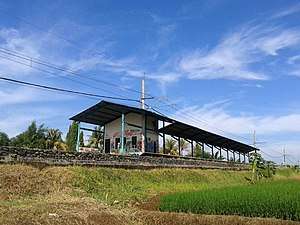
.jpg)
Ireland
A "ghost station" exists on the Luas tram system in Dublin, on the Green Line between Ballyogan Wood and Carrickmines. It was intended to service new suburbs, but the post-2008 Irish economic downturn meant that the suburbs were never built and the tram passes through empty fields at that point on the line. The station is labelled "Future Stop" on the route map; it will be called "Brennanstown" if and when it opens.[9][10]
Italy
Italy does not have a long list of ghost stations. Amongst the few examples is Quintiliani, on Line B of the Rome Metro. It was built in 1990 as part of the extension towards the northeast of Line B, but was kept unused because it was meant to serve a planned business district called Sistema Direzionale Orientale (Eastern Directional District) that was never realized.[11]
In the early 2000s the project of the S.D.O. was cancelled and the station, which was in the middle of nowhere, was taken in charge by the Municipality of Rome and renewed to make it compliant with the new security rules issued in the meantime; a new bus line was established to link the station to the nearby Sandro Pertini general hospital. On 23 June 2003 it was officially opened to passenger traffic,[11] ending a 13-year long period of ghost station status.
Japan
- Hakubutsukan Dōbutsuen station on the Keisei Main Line (closed in 2004)
- Kaede station on the JR Hokkaido Sekishō Line (closed in 2004)
- Manseibashi station on the Tokyo Metro Ginza Line (closed in 1931)
Malaysia
- Rantau Panjang railway station is a partially disused railway station owned by Keretapi Tanah Melayu (KTM) which is a part of the Rantau Panjang extension of KTM Intercity's East Coast Line in Rantau Panjang, Kelantan. After DMU drivers from Thailand refused to stop their railcars between Rantau Panjang and Tumpat, it is reused by Eastern and Oriental Express trains as a railway station for emergency purposes.
- Sri Rampai station on the PUTRA LRT/Kelana Jaya line in Kuala Lumpur. Partially completed during construction between 1994 and 1999 but remaining inactive and mothballed for a decade after the opening of the line, as ridership via the station was initially projected to be too low. Completed and opened in December 2010 following new property developments around the station.
New Zealand
- Helensville railway station on Auckland's Northern Line closed in 2009
- Kumeu railway station on Auckland's Northern Line, a temporary stop in 2008 and 2009
- Waimauku railway station on Auckland's Northern Line closed in 2009
- Waitakere railway station with electrification terminating at Swanson, this station has closed (2014)
North Korea
- Pyongyang Metro – Kwangmyŏng station (Korean: 광명) has been closed since 1995 when the mausoleum of Kim Il-Sung was opened atop that station.
Norway
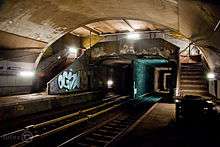
- Valkyrie plass on the Oslo Metro
- Volvat on the Oslo Metro
- Elisenberg in the Oslo Tunnel
All three are real ghost stations, underground stations with trains passing through.
Portugal
Lisbon Metro
- Reboleira: The station started to be constructed on schedule, but was not completed for some time due to the 2010–14 Portuguese financial crisis. In June 2015, the Metropolitano de Lisboa company announced[12] that the construction of the station and of the connecting line would be resumed, and that the station would be operational. This metro station opened in 13 April 2016.
- Arroios: This station was closed for renovations in late 2017, and was originally expected to reopen in late 2019; however, the renovations of that station have been delayed.
Russia
Moscow Metro
- Vystavochnaya (opened as "Delovoy Tsentr"): only one of three stations in the complex is opened, the other two stations are built in as provisions. A part of the platform is a temporary picture gallery.
- Pervomayskaya (depot) and Kaluzhskaya (depot): Temporary stations built in the respective metro depots. After the lines they were serving were extended and proper stations built, these were closed.
Saint Petersburg Metro
- Dachnoye, a bay platform opened in 1966, closed in 1977, a part of the platform was rebuilt as a police building.
Nizhny Novgorod Metro
- Yarmarka, located between the Moskovskaya and Strelka stations. Its construction was started in 1993, but was discontinued in 1996. At first, in this station there was a headshunt for trains. After the opening of the Strelka station you can see the branch and expansion of the tunnel for the station. Presumably this station will be completed after 2020.[13]
Novosibirsk Metro
- Sportivnaya, a station of the Novosibirsk Metro.
Singapore
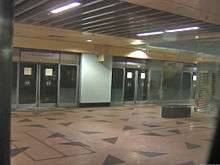
- Bukit Brown is an unopened station along the Circle line. It is currently only a shell station with a ventilation shaft.
- There is an unopened station box on the Downtown line between Hillview and Beauty World tentatively named Hume station.
- Several stations on the Punggol LRT, including the entire West Loop, did not open with the rest of the line in 2005. Nearly all of these stations have since opened for service alongside developments in their respective areas. As of 2017, only one station, Teck Lee, remains closed, as it is currently surrounded by jungle.
- There is a reserved space for a new station on the North East line between HarbourFront and Outram Park but there is no station box there. Two other stations were constructed on the line but did not open with the rest of the line in 2003; these were Buangkok and Woodleigh, which subsequently opened in 2006 and 2011, respectively.
- Ten Mile Junction station on the Bukit Panjang LRT opened in November 1999, and was permanently closed on 13 January 2019, to facilitate upgrading works for the line. The station was previously closed from late 2010 to early 2012 for refurbishment works.
South Korea
- A second platform for Seoul Subway Line 2 at Sinseol-dong station
Spain
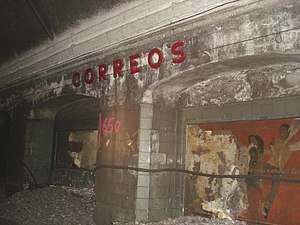
- Disused Barcelona Metro stations
- Chamberí in Madrid Metro
- El Tejar, San Martín de la Vega and Parque de Ocio in Cercanias Madrid
Sweden
- Kymlinge in Stockholm Metro (trains pass through it)
- Rannebergen in Gothenburg (prepared underground station not used by trains)
Ukraine
- Vulytsia Hertsena, Lvivska Brama and Telychka in the Kiev Metro
- Vovnopriadylna in the Kryvyi Rih Metrotram
United Kingdom
United States
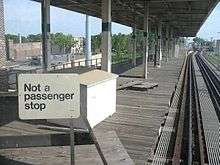

- Euclid–East 120th on the RTA Rapid Transit in Cleveland
- Nine stations on the New York City Subway, as well as two stations on the PATH system
- Franklin Square on the PATCO Speedline and Spring Garden on the Broad-Ridge Spur in Philadelphia
- Six stations on the Chicago "L"
- Three stations on the VTA light rail system in San Jose, as well as Eureka Valley in San Francisco
- The unused east–west platform at Government Center Station on the Metrorail in Miami
- Harvard-Holyoke near Boston
- The former platforms of the Gateway station in Pittsburgh
- 29th & Welton in Denver
- Subway Terminal Building in Los Angeles contains an abandoned station in the basement with its terminus at Belmont Tunnel/Toluca Substation and Yard. The tunnel was bisected by new construction in the early 21st century.
See also
References
- Originally 15 km/h (9 mph), after an East German policeman tried to jump on a moving train the mandatory speed was later increased to 25 km/h (16 mph). Jürgen Meyer-Kronthaler, Klaus Kurpjuweit, Berliner U-Bahn – In Fahrt seit über hundert Jahren, be.bra verlag 2009 p. 119
- Las estaciones clausuradas de la línea A – EnElSubte, 24 April 2014. (Spanish)
- Realizarán estudios en Constitución para ubicar la cabecera de la línea F – EnElSubte, 1 August 2011. (in Spanish)
- "Toronto's Lost Subway Stations". Transit Toronto. Retrieved 9 November 2014.
- Calgary Inside Out (4 May 2008). Underground City Hall C-Train. Calgary: Global News – via YouTube.
- "Národní Třída Station Closure". Praha.eu (Portal of Prague). 28 June 2012. Retrieved 8 June 2017.
- "Helsingin alla kummittelee neljä haamuasemaa – HS tutustui kummajaisiin". Helsingin Sanomat. 15 February 2015.
- mainonta, Yhteystiedot Plaza fi Nettix Oy Maistraatinportti 100240 Helsinki Nettix Oy on osa Otava-konsernia ja olemme osa Otavamedian mainosverkostoa Käyttäytymiseen perustuva. "Helsingin alla kummittelee neljä haamuasemaa – HS tutustui kummajaisiin".
- Fearon, Alana (6 February 2017). "Is the Luas finally going to Sandyford?". dublinlive.
- Gartl, Fiona. "All aboard for fun day out on the Luas". The Irish Times.
- Mattone, Alberto (9 April 2003). "Metro B, apre una nuova stazione" [Line B, a new station has been opened]. la Repubblica. Rome. Retrieved 18 August 2019.
- Lusa. "Metro retoma obras na ligação à Reboleira". Público. Retrieved 8 June 2017.
- "10 неожиданных фактов о Нижнем Новгороде". www.nn.aif.ru (in Russian). 22 May 2017. Retrieved 28 January 2019.
External links
- Historic Berlin metro maps (in German)
- View from the cab of a journey from Gesundbrunnen to Leinestraße in a Berliner Verkehrsbetriebe museum train in 1987, passing through several ghost stations (German captioning)
- Except from a documentary on the ghost stations
- "Transit durch den Osten: Die Geisterstrecken unter Ostberlin". Berliner Untergrundbahn. Archived from the original on 14 December 2011. Retrieved 30 November 2017.
